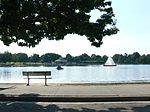Powhite Parkway Bridge
Bridges completed in 1973Bridges in Richmond, VirginiaBridges over the James River (Virginia)Road bridges in VirginiaSouthern United States bridge (structure) stubs ... and 3 more
Toll bridges in VirginiaVirginia building and structure stubsVirginia transportation stubs

Powhite Parkway Bridge crosses the James River in the independent city of Richmond, Virginia. It carries the Powhite Parkway, also known as Virginia State Route 76. The bridge is owned and maintained by the Richmond Metropolitan Authority, and was funded with revenue bonds which are repaid from user tolls. There is no bridge toll to cross the Powhite Parkway Bridge, however the toll plazas located south of the bridge prohibit drivers from crossing the bridge without paying a Powhite Parkway toll.
Excerpt from the Wikipedia article Powhite Parkway Bridge (License: CC BY-SA 3.0, Authors, Images).Powhite Parkway Bridge
Powhite Parkway, Richmond
Geographical coordinates (GPS) Address External links Nearby Places Show on map
Geographical coordinates (GPS)
| Latitude | Longitude |
|---|---|
| N 37.539277777778 ° | E -77.496111111111 ° |
Address
Powhite Parkway Bridge
Powhite Parkway
23225 Richmond
Virginia, United States
Open on Google Maps











